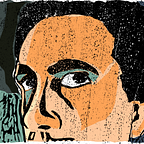Parametric versus raster brushes
Comparison between parametric and static raster brushes on GIMP.
Which is better as classical brush, the parametric or (static and dynamic) raster brush?
On Gimp the brush set have an small quantity of parametric brushes… why reason? Sincerely I do not know, perhaps, many illustrators, concept artists, photographers have been accustomed to see/utilize only raster brushes.
My idea is very simple: until point the parametric as a classical brush could be used on digital painting?
Making a test
I though a simple test … I did a parametric calligraphic brush, very small with radius equal to 12.
After I’ve made a stamp of my parametric brush and build a .gbr brush.
From my tests among both brushes, it results that the parametric is better than its equivalent .gbr, if are thinking in classic dabs, round, square, diamond and variations of shape forms based in Spikes.
The stroke of parametric brush is more sharpest and hard … is much easy to increase the softness in this case … instead the .gbr when we increase/decrease the hardness the stain is deformed and the blur is not good we have in the parametric brushes. See the bug report.
Short library of shapes and strokes
The shapes are very different among round, square and diamond, the default shapes. So, is possible create a great variation of the shapes, mainly with the different parameter options to control the shape and its aspect (radius, spikes, hardness, aspect ratio, angle and spacing).
How to combine parametric and paint dynamics
I think is not possible have an univocal rule to combine brushes with paint dynamics, instead is possible to say that, in general, that each paint dynamics represents an effect or a different technique.
To Do
For the parametric brushes we need rebuild a collection of paint dynamics more simple… per example:
Dry medias (pencil, crayon, charcoal)
I think that an unique dynamic is capable emulate practically all these dry medias. Is possible to identify many brushes, rasters and/or parametric, that can be utilized with this paint dynamic … more opaque and darken is possible emulate charcoal and oil crayon … less opaque and lighter, the dry crayons and pencils. Basically the paint dynamic emulates the technique and the brush emulates the characteristic stain quality of the media. In this sense, the brush simply show us which is the difference between a real dry brand media dab and our emulation.
My Paint Dynamics is here: pencil-generic-jag.gdyn
My paint dynamics based on the “generic pencil” with many kind brushes.
Testing of dry media brushes and paint dynamics to GIMP
See other tests published on my g+ account:
- Testing a Paint dynamic to the dry media.
- Dry media paint dynamics for #gimp with different raster brushes, in this case all are the .gih brushes, with different opacity’s heavy.
- Using my dry media paint dynamics for #gimp (a variant of Pencil Generic).
- Testing dry media paint dynamics for #gimp with parametric brushes.
- Short comparison schema to dry media between parametric and raster brushes on GIMP.
- My final test about the behavior of paint dynamics for dry medias on #gimp with different brush types (parametric and raster).
- Another comparison test between raster and parametric brushes.
- A filter ready to collect all my brush experiments with ‘jitter’ tag.
Dry Media and around
One of aspects more beautiful of dry medias, is the mixing and cover-up ability. With a simple brush is possible simulate fine a dry media stroke, but not the mixing/blending. For this, is necessary a paint dynamic with some impasto or blending qualities. I see, only the effective blend between the strokes and not only as an ‘sfumino’ technique … then, is useful understand this behavior through others ways, for instance, how the blend modes applied directly on paint tools helping the paint dynamics solve in elegant way.
Is possible emulate the blending with blend filter directly on brush with Mode. I prefer in these cases the ‘Darken Only’, mainly the stains with successive passages are not darken.
Ink medias (china ink pen, rapidograph pen, felt-tip, markers)
The strokes or typical stains of these tools are very dependent of the canvas support: smooth, rough, glossy, matte, textured, absorbent or not, etc …
For the Ink medias, normally we have the paper as support. Imagine an old ink pen on a smooth and glossy paper … the stroke is thin and precise but can drool in the curves or on the direction’s change.
Another case is could be, always, an old ink pen but with a rough paper and absorbent (watercolor paper, for instance), the stroke line can be imprecise with noise along strokes and paths.
For each of these cases, ideally, is not possible have a unique paint dynamic, but two. Perhaps, is possible to build an unique paint dynamic but with different brushes, and in this case only raster brushes, mainly the .gih brushes (animated brushes) are capable to emulate these characteristics.
[To Do > Soon ;-)]
Dry media simple, Dry media with soft and hard blending
China Ink pens
Rapidograph pen and similar (size-fixed)
Felt and marker pens
Painting Media
Sketching Medias
Textured Brushes: #TexturedBrush on G+
